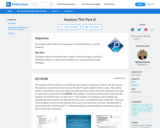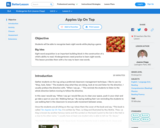
Finding measures of central tendency will be applied to the different graphs throughout this unit.
- Subject:
- Mathematics
- Material Type:
- Lesson Plan
- Provider:
- BetterLesson
- Date Added:
- 12/01/2022

Finding measures of central tendency will be applied to the different graphs throughout this unit.

Srudents connect mean, median, mode and range to real life. It will allow students to make sense of problems by using previously taught strategies.

This unit is all about linear relationships and functions.

Students will be able to analyze literary devices by participating in a written discussion. This activity is called "Pass the Paper". Students pass a sheet of paper around the room, with each student adding on. It's just a different way to have a discussion to help students make meaning. Examples and worksheets are included.

This lesson will help students read and comprehend nonfiction, specifically biographies, through determining criteria for text complexity. Included is a PDF and Smart Notebook titled Determining Text Complexity, and an example of a student's work.

Students will be learning through exploration on how to analyze and create circle graphs and Venn diagrams.

Through the use of movement and observation, the students will be able to identify objects that can be moved and identify and problem solve how to move objects. Included in this lesson are videos of the activity, a vocabulary chart, and examples of students' work.

Empower students to recognize that they are thinkers and writers! They will collaborate on a writing piece to brainstorm, organize and publish ideas with a digital tool. This lesson highlights different website creations as examples of writing to show just a few of the MANY MANY ways you can write on the web. A powerpoint demonstration is included as well as video examples of students' completed work.

Students will explain commonalities in animal life cycles as well and to compare life cycles of different animal groups.

The numbers in an addition number sentence (addends) can be added in any order and the sum remains the same.

Grades K-3. Sight word acquisition is an important building block in the construction of a child's ability to read. Kindergarteners need practice to learn sight words. This lesson provides them with a fun way to learn new words.

Using base-ten materials and place-value skills, students gain a better understanding of how to add and subtract numbers.

Students will be able to identify similarities and differences between two texts about the polar habitats by using a Venn diagram. Included in this lesson are guided questions to use while reading, a printable Venn Diagram, and pictures of completed students' work.

Students will be able to identify similarities and differences between two texts on the same topic. After reading and discussing books on the Arctic and Antarctic, they will use a Venn diagram and assorted images to compare and contrast the habits. Extensive resources are included such as worksheets, images, an assessment checklist, examples of student work, and video of the lesson in action.

Students combine like terms and simplify expressions with multiple terms and variables.

Come and discover ways to see in the dark! Students will conduct an investigation on light and dark. The investigation will allow students to gather evidence on how items illuminate. Using cause and effect, the students will demonstrate an understanding of objects illuminating using an external light source. Students will record their observations and evidence in their scientific journals.

Students look at making wise consumer decisions by figuring out what is the better deal.

Area questions can be asked multiple ways and the area can be found by using different strategies.

Creating names with block letters students calculate area of irregular shapes. This activity also make a real world application to the popular video game Minecraft.

Students develop spatial reasoning about large areas through composing and decomposing rectangles to determine area.